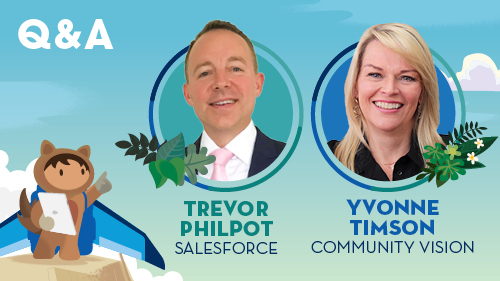How Community Vision Transformed Customer Engagement for Life-Changing Outcomes



Community Vision is a not-for-profit providing aged care and services to people living with a disability or dementia, as well as family day care. Its core value is to support people to live their lives their way and to nurture more connected communities.
After our latest research into customer engagement found that the relationships between customers and brands were upended in 2020, our WA State Director Trevor Philpot spoke with Community Vision COO Yvonne Timson about the changes her organisation had been making to its customer engagement strategy and operations prior to 2020 to achieve truly life-changing outcomes, and how the pandemic has impacted its transformation.
Trevor Philpot: What challenges was Community Vision facing two years ago?
Yvonne Timson: Something as straightforward as cancelling or rescheduling an appointment was difficult for both the customer and for us. All our rosters were painstakingly created on paper and any change to them was a big deal. Two weeks worth of work creating a roster could go up in smoke in five minutes. It was inefficient and frustrating for everyone involved.
Trevor: What changes has Community Vision made to that system in the past few years?
Yvonne: Paper rosters are, thankfully, a thing of the past! All our support workers are completely mobile now with an iPad to work from wherever they are. With Salesforce Field Service, an appointment can be easily changed and everyone can see it in real time in the app.
Customers can use Community Cloud to make changes or they can talk to someone in the central office about changing a scheduled appointment – all without anyone having to track down a support worker in the field.
Support workers also have notes and records about their customer at their fingertips on each visit as well. They can compare their customer’s condition to those notes and, if they notice a decline or difference, they can pass that information on and it can be actioned in real-time – a care manager or nurse can visit or video call to check on the customer. Those video calls are then recorded, or notes are taken in real-time in the app during in-person visits, and kept as part of our complete view of the customer.
Trevor: There are finite dollars in any care package and there is always downward pressure. How is technology enabling Community Vision to stretch the capacity of customers’ funding?
Yvonne: Our time is no longer being eaten up by time-consuming and inefficient manual admin tasks like rostering. By utilising innovative technological solutions, we are able to deliver services in new ways that help customers’ funding better cover their needs.
Let me give you an example. The best care for an individual might include daily medication prompts and check-ins. But their funding might cover two home visits a week – this is the sort of seemingly small barrier that can cause a move to residential care.
Now, instead of sending someone out to a customer on two days each week, we can video call them for the medication prompt every day, guide them if they need assistance and make an accurate record of the medication having been taken.
The dollars are more effectively spent on the outcomes our customers need.
Trevor: Are your customers generally open to digital engagement? Has the pandemic changed the way you engage with your customers?
Yvonne: COVID made our customer base much more open to technological solutions than they might otherwise have been. I saw customers singing with their regular choir groups online and connecting with family they hadn’t seen for years via video calls. So while it was a challenging time, there was also an opportunity to push forward with innovative solutions to our customers’ needs – they responded with great willingness.
Most of our customers are vulnerable and had to stay isolated during the pandemic or are in aged care facilities that went into lockdown. Either way, we were not about to let the pandemic derail our relationships with our customers and the support they needed. We didn’t stop delivering any of our services – we just did it in different ways.
We have a disability customer, for example, who lives in a residential aged care facility. The highlight of this man’s week is getting his Wednesday night takeaway with his support worker. Suddenly this very important connection was impossible because the aged care facility was in lockdown.
So his support worker taught him how to order online and have food delivered. In an incredibly restricted environment, this customer learnt a new, empowering skill. And our support workers maintained that all-important human connection with their customers.
Our technological transformation has enabled beautiful outcomes around wellness in the most holistic sense – and in a very cost efficient way.
Trevor: Tell us about your vision for the next two years – what do you hope to achieve?
Yvonne: We don’t ‘hope’ to meet our goals – we plan to and will meet them!
One of the big ones that will further contribute to our cost effectiveness as a business is to fully automate the back office suite so there’s no manual element to it. We’re also going to stop posting physical mail – that’s a challenge for some of our customers but we can do it and the savings in resources and cost will be significant.
I firmly believe that being strategic and commercially minded isn’t at odds with being a purpose-driven not-for-profit. Indeed, the better we do as a business, the better the outcomes are for our customers.
We will keep putting our customer front and centre, and seeking their ongoing feedback and insights. My grandmother used to say, “never ask a question you don’t want to hear the answer to”. I would say “we want to hear all the answers – even the tough ones”. We’re open to being challenged – by customers and by our team members, who we encourage to be creative and not just do things the way they’ve always been done.
I’m also looking forward to partnering and collaborating with smaller NFPs in our sector over the next two years. We’re in a strong position to share our capabilities and enable smaller providers to deliver their services more efficiently.
Trevor: And what about in the medium to long term? What do you want to see happen in this sector?
Yvonne: I want to see disability accepted as mainstream, and truly dementia-friendly communities. We know the population is getting older, and the number of dementia-related diagnoses is increasing, including early-onset dementia. We don’t yet know what the long-term effects of COVID-19 will be but are mindful they could include memory loss.
So I’m looking at how we can maintain the momentum of innovation that we saw come to the fore during the pandemic.
And I want to see greater promotion of the good news stories around how technology can contribute to helping people stay at home for longer, living on their own terms, in their own communities and being in control of what happens to them.
Trevor: Is there a danger of technology gradually homogenising services and thus becoming less personalised?
Yvonne: We’ve seen that happen in the past with, say, some of the big telco companies that went too far and had to back-peddle dramatically to meet the customer demand for personalisation. We’ve learnt a lot though.
None of this is about replacing human connection with technology. On the contrary, it’s about augmenting the people who contribute to the care of our customers, making connections possible in new ways and staying customer focused at all times so we can keep meeting individuals’ needs. It’s about staying thoroughly tuned into our customers. The flexibility of the platforms we’re using means we can put more time and money into delivering better customer outcomes.























